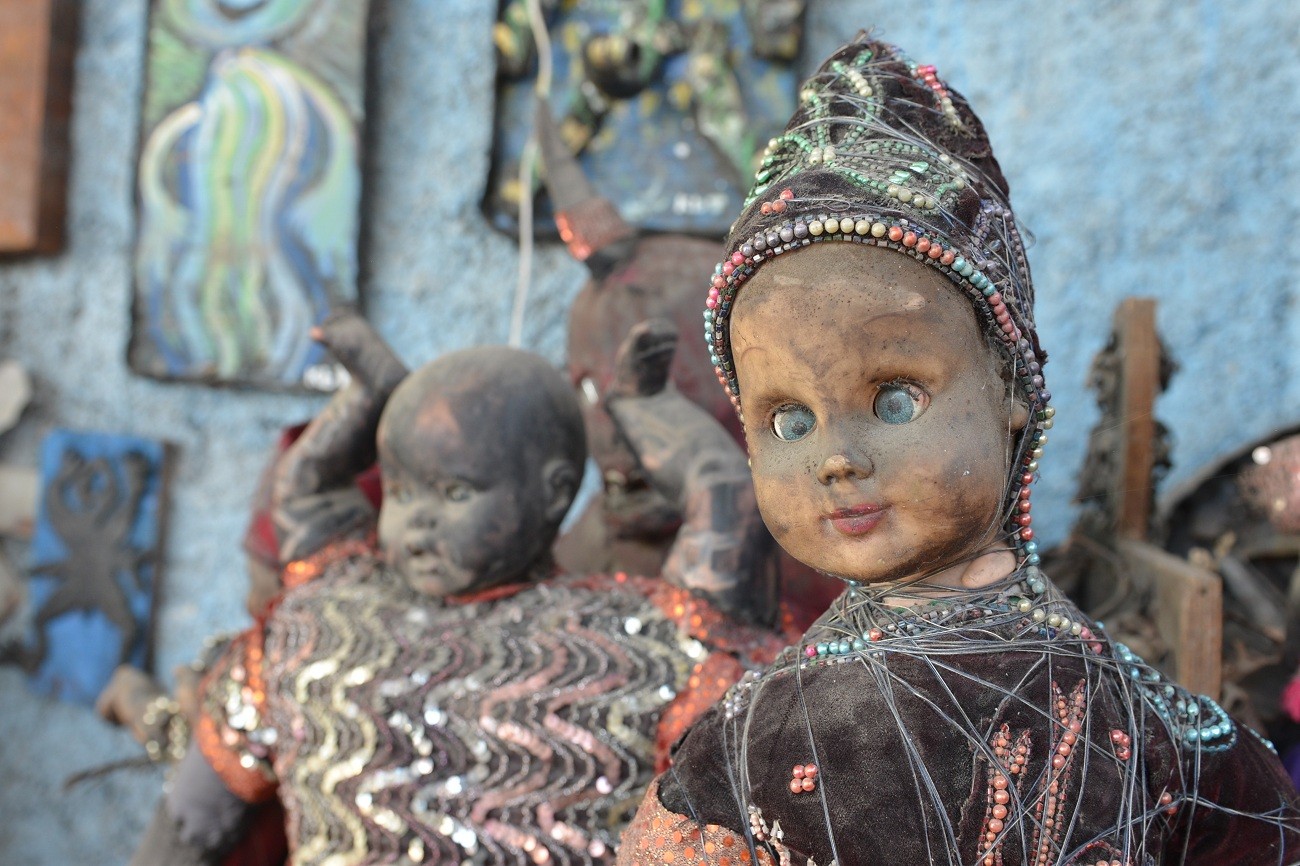Haiti artists forge int'l reputation with art made of junk
Change text size
Gift Premium Articles
to Anyone
 In this April 2, 2016 photo, dusty sculptures made of cast-off baby dolls sit in an open-air museum and art workshop off a trash-strewn street cutting through some of the poorest neighborhoods in Port-au-Prince, Haiti. They were created by Haitian artists called Atis Rezistans who have become celebrated in the international art world by creating sculptures out of scrapped car parts, old wood, discarded toys and even human skulls found scattered outside crumbling mausoleums. (AP/David McFadden)
In this April 2, 2016 photo, dusty sculptures made of cast-off baby dolls sit in an open-air museum and art workshop off a trash-strewn street cutting through some of the poorest neighborhoods in Port-au-Prince, Haiti. They were created by Haitian artists called Atis Rezistans who have become celebrated in the international art world by creating sculptures out of scrapped car parts, old wood, discarded toys and even human skulls found scattered outside crumbling mausoleums. (AP/David McFadden)
A
mid a maze of car repair shops in Haiti's gritty capital, Andre Eugene pitches a shredded tire he found atop a towering sculpture he built out of rusty engine parts, bed springs and other cast-off junk.
"This is what I do: I work with the garbage of the world," says Eugene, assessing the largest sculpture displayed at the entrance of his studio and open-air museum off a crumbling street cutting through some of Port-au-Prince's poorest neighborhoods.
The Haitian sculptor is a founding member of Atis Rezistans, a shifting collective of artists who recycle whatever useful scraps they can find to give a raw, physical shape to the spiritual world of Voodoo, or Vodou as the religion is known by Haitians, and weigh in on the country's chronic political and economic troubles.
While Haiti's established galleries were slow to warm to the scrap sculptors of the capital's impoverished Grand Rue neighborhood, bustling with furniture-makers and other craftsmen, the artisans working with recycled materials have been embraced by a number of international art connoisseurs and academics.

Over the last decade, the work of Atis Rezistans has been exhibited in cities such as Paris, London, and Los Angeles. There are sculptures included in the permanent collections of museums, including the Frost Art Museum in Miami.
Haitian art has long had a reputation for imaginative richness, and wealthy international collectors including Jacqueline Kennedy Onassis and filmmaker Jonathan Demme sought out self-taught painters colorfully evoking the everyday lives of Haitians or depicting dreamlike scenes. And even though found-object creations have been part of the poor country's art for decades, experts say there has been nothing like the in-your-face works of Atis Rezistans.
"Atis Rezistans takes an old practice in new directions, expanding the range of materials used and offering stunning new meanings for objects found in everyday life," said Marcus Rediker, a collector of Haitian art and a distinguished professor of Atlantic history at the University of Pittsburgh.

The materials that form the sharp-edged sculptures include automotive fragments, carved wood pieces, broken TVs, discarded toys and even real human skulls collected at a cemetery of mausoleums where bones were scattered by grave robbers.
Many of their artworks are a nod to Baron Samedi, the Vodou god of the dead, and his rambunctious offspring, Gede. Others offer a kaleidoscope of jarring images out of a Mad Max movie: sculptures of faces with spikes; masked figures resembling shrouded corpses; broken baby dolls fused with computer motherboards.
But it's not all darkness. There's plenty of evidence of playfulness and irreverent theatricality, such as a skull-topped figure with a stethoscope, snake sculptures with scales of inlaid bottle caps and much frank sexual imagery.
Perhaps their most acclaimed collaborative creation has been a mashup of high art-meets-developing world called the "Ghetto Biennale." Every two years, international artists come to the Grand Rue neighborhood in a kind of cross-cultural festival that leaves the door open for just about anything.
The Ghetto Biennale takes a form developed for European art fairs and radically subverts it, according to Anthony Bogues, a Brown University professor who co-curated a 2011 exhibition of Haitian art at the Providence, Rhode Island school.
"Art for them is not about the elite but rather recognizing that art is a language in which Haiti speaks to itself and the world," Bogues said of Atis Rezistans.

Collaborations with overseas artists who come to Haiti have given younger members of the collective chances to tap into art networks across the globe, while international artists are stimulated by the Haitian group's creative process.
"Their philosophy to turn trash into art, thus something seemingly worthless into something valuable, has inspired me," said Alice Smeets, a Belgian artist who collaborated with members of Atis Rezistans to create staged photographs in Haitian slums that depict figures from tarot cards.
Eugene hopes that the praise gathered for the group he founded with Celeur Jean-Herard, who has since departed the collective, can now translate into enough earnings to upgrade his yard's musty museum and improve the lives of members. and local youngsters dubbed "children of the resistance" who sculpt and paint.
Though he has traveled the world with his art, Eugene still lives in a small concrete shack next to his Grand Rue workshop and "Musee d'Art," where many sculptures are caked with dust and swathed in cobwebs. Two turkeys and several cats were the only visitors one recent afternoon.
He calls Atis Rezistans a social "movement" that should expand opportunities for its artists.
"I don't want to be famous," Eugene said in his rain-slicked concrete yard in the poor neighborhood, shortly after returning to Haiti from an exhibit of a major piece in Milan. "Step by step, I am looking to make money so we can improve our situation here."









